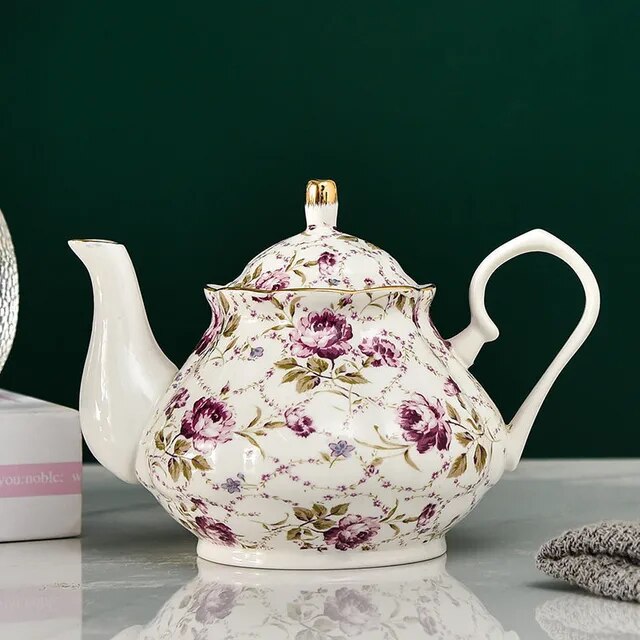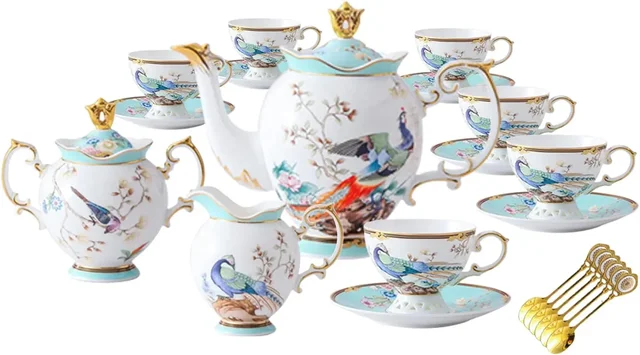
Tea time is more than just a daily ritual; it’s an opportunity to savor a moment of tranquility, connect with friends, and indulge in a cherished tradition. The right teapot and tea set can transform an ordinary tea session into a special occasion, adding elegance and functionality to your tea-drinking experience.
In this article, we’ll explore the significance of teapots and tea sets, different styles and types, and how to choose and care for these essential items to enhance your tea enjoyment.
The Significance of Teapots and Tea Sets
These have long been integral to tea culture, serving both practical and aesthetic purposes:
1. Historical Context
Teapots have been used for centuries, with their origins tracing back to China during the Tang Dynasty (618-907 AD). Initially made of clay, teapots evolved in design and material over time, reflecting the cultural and technological advancements of various societies. The art of tea drinking spread to Japan, Europe, and beyond, leading to the creation of diverse styles and designs.
2. Cultural Importance
Teapots and tea sets are deeply rooted in cultural traditions and ceremonies. In China, the Gongfu tea ceremony emphasizes the art of brewing and serving tea with precision and mindfulness. In England, afternoon tea is a social tradition where tea sets are used to serve tea and accompanying treats, showcasing elegance and refinement.
3. Modern Usage
These are appreciated not only for their practicality but also for their aesthetic appeal. They come in various designs and materials, allowing tea enthusiasts to choose sets that reflect their personal style and elevate their tea-drinking experience.
Types of Teapots
Teapots come in a variety of styles and materials, each offering unique features and benefits. Here’s a look at some popular types:
1. Ceramic Teapots
Ceramic teapots are known for their versatility and aesthetic appeal. They are often glazed or painted with intricate designs and come in various shapes and sizes. Ceramic teapots retain heat well, making them ideal for serving tea at the desired temperature. Common types include:
- Porcelain Teapots: Fine and delicate, porcelain teapots are often adorned with decorative patterns and are suitable for formal occasions.
- Stoneware Teapots: Durable and practical, stoneware teapots have a rustic charm and are great for everyday use.
2. Cast Iron Teapots
Cast iron teapots, or tetsubin, are traditional Japanese teapots known for their durability and heat retention. They often come with an enamel coating on the inside, preventing rust and making them suitable for brewing a variety of teas. Cast iron teapots have a classic, heavy feel and are available in various designs.
3. Glass Teapots
Glass teapots allow you to see the tea as it brews, making them visually appealing and functional. They are typically made from heat-resistant borosilicate glass, which can withstand high temperatures. Glass teapots are ideal for brewing loose leaf tea and for those who enjoy watching the tea’s color and infusion process.
4. Stainless Steel Teapots
Stainless steel teapots are known for their modern appearance and durability. They are resistant to staining and corrosion, making them easy to clean and maintain. Stainless steel teapots often come with features such as heat-resistant handles and built-in infusers for convenience.
5. Electric Teapots
Electric teapots offer convenience with their fast boiling capabilities and automatic shut-off features. They are typically made from stainless steel or plastic and come with variable temperature settings for different types of tea. Electric teapots are practical for those who value efficiency and modern technology.
Types of Tea Sets
A complete tea set includes various components designed to enhance the tea-drinking experience. Here’s a look at the essential items in a tea set:
1. Teapot
The centerpiece of any tea set, the teapot is used to brew and serve tea. It should be chosen based on material, size, and design to suit your tea preferences and serving style.
2. Tea Cups
Tea cups are designed for drinking tea and are available in various styles, such as:
- Traditional Tea Cups: Often made of porcelain or ceramic, traditional tea cups are typically paired with saucers and are used for formal tea settings.
- Mugs: Larger and more casual, mugs are suitable for everyday use and can be made from ceramic, glass, or stainless steel.
3. Saucers
Saucers are small plates placed under tea cups to catch drips and provide a convenient spot for stirring spoons or teabags. They are often matching with tea cups and add a polished touch to your tea set.
4. Creamer and Sugar Bowl
The creamer is used for adding milk or cream to tea, while the sugar bowl holds sugar cubes or granules. These items complete a traditional tea set and are essential for serving tea with milk and sugar.
5. Tea Infuser
A tea infuser is a small mesh or perforated container used for brewing loose leaf tea. It is placed inside the teapot or tea cup to hold the tea leaves and allows for easy removal after brewing. Infusers come in various shapes and sizes, including ball, basket, or spoon styles.
6. Tea Strainer
A tea strainer is used to filter out loose tea leaves or herbs from the brewed tea. It is placed over the cup or teapot to catch any remaining leaves, ensuring a smooth and enjoyable tea-drinking experience.
Choosing the Perfect Teapot and Tea Set
Selecting the right teapot and tea set involves considering several factors to ensure they meet your needs and preferences. Here are some tips for choosing the perfect set:
1. Material and Design
Consider the material and design of the teapot and tea set. Choose a material that suits your style and practical needs. For example, porcelain and ceramic offer elegance, while cast iron provides durability. The design should complement your decor and personal taste.
2. Size and Capacity
Choose a teapot and tea set with appropriate size and capacity based on how many people you typically serve. Small teapots are ideal for individual servings, while larger ones are suitable for gatherings. Ensure that the tea cups and other components match the teapot’s size.
3. Functionality
Consider the functionality of the teapot and tea set. Features such as built-in infusers, heat-resistant handles, and easy-to-pour spouts can enhance convenience and usability. For electric teapots, look for features like variable temperature settings and automatic shut-off.
4. Style and Aesthetics
Select a tea set that matches your style and complements your home decor. Whether you prefer a classic, modern, or whimsical design, there are numerous options available to reflect your personality and taste.
5. Budget
Determine your budget for the teapot and tea set. While high-end options may offer superior quality and craftsmanship, there are also affordable sets that provide excellent value. Choose a set that fits your budget while meeting your quality and aesthetic preferences.
Caring for Your Teapot and Tea Set
Proper care and maintenance ensure that your teapot and tea set remain in good condition and continue to enhance your tea experience. Here’s how to care for them:
1. Cleaning
Clean your teapot and tea set after each use to prevent residue buildup. Use gentle detergents and avoid abrasive cleaners that can damage the surfaces. For glass teapots, use a soft cloth or sponge to avoid scratching.
2. Drying
Ensure that your teapot and tea cups are thoroughly dried before storing them. This prevents moisture from causing mold or mildew, especially in wooden or metal components.
3. Storage
Store your tea set in a cool, dry place to avoid damage from humidity or extreme temperatures. Use a protective cover or storage box to keep dust and debris off your teapot and cups.
4. Regular Maintenance
Check for any signs of wear or damage, such as cracks or rust, and address them promptly. For cast iron teapots, regularly season the interior to maintain its condition and prevent rust.
Conclusion: Embrace the Art of Tea with the Perfect Teapot and Tea Set
A well-chosen teapot and tea set can elevate your tea-drinking experience, turning an everyday ritual into a moment of elegance and enjoyment. By understanding the significance of different materials, designs, and components, you can select a teapot and tea set that reflects your style and enhances your tea moments.
Embrace the art of tea with a teapot and tea set that perfectly suits your preferences and adds a touch of sophistication to your tea gatherings. With the right combination, you’ll enjoy not only the flavors of your favorite teas but also the pleasure of a beautifully curated tea experience.



